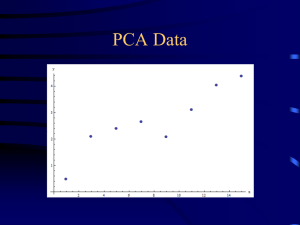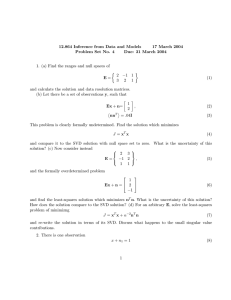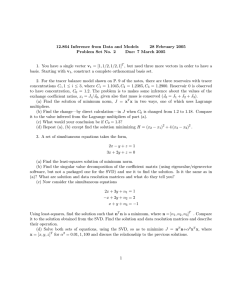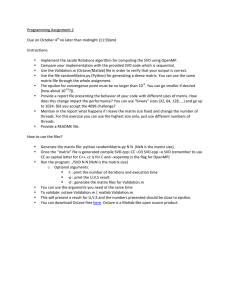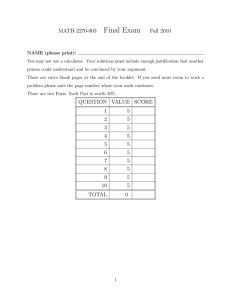Column Subset Selection on Terabyte
advertisement
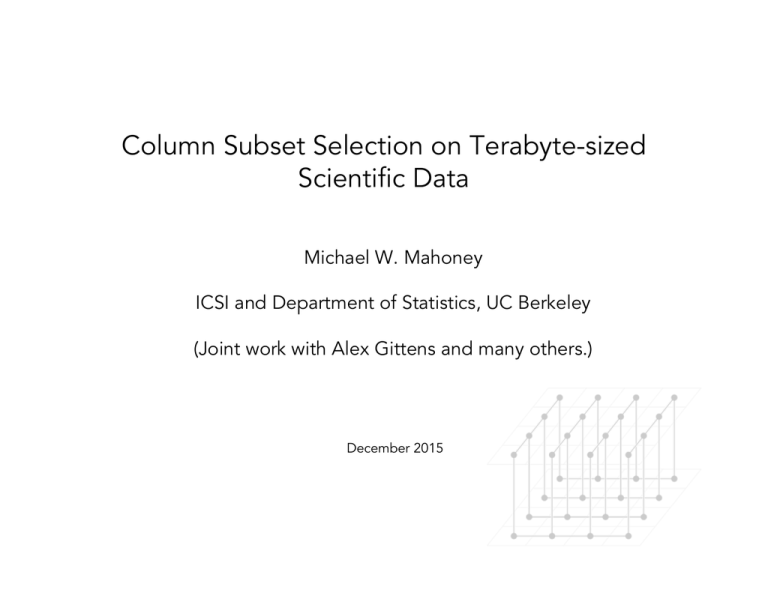
Column Subset Selection on Terabyte-sized
Scientific Data
Michael W. Mahoney
ICSI and Department of Statistics, UC Berkeley
(Joint work with Alex Gittens and many others.)
December 2015
Overview
Comments on scientific data and choosing good columns as features.
Linear Algebra in Spark
• CX and SVD/PCA implementations and performance
Two scientific applications of Spark
• Applications of the CX and PCA matrix decompositions
• To mass spec imaging, climate science (etc.)
Scientific data and choosing good columns as features
E.g., application in: Human Genetics
Single Nucleotide Polymorphisms: the most common type of genetic variation in the
genome across different individuals.
They are known locations at the human genome where two alternate nucleotide bases
(alleles) are observed (out of A, C, G, T).
SNPs
individuals
… AG CT GT GG CT CC CC CC CC AG AG AG AG AG AA CT AA GG GG CC GG AG CG AC CC AA CC AA GG TT AG CT CG CG CG AT CT CT AG CT AG GG GT GA AG …!
… GG TT TT GG TT CC CC CC CC GG AA AG AG AG AA CT AA GG GG CC GG AA GG AA CC AA CC AA GG TT AA TT GG GG GG TT TT CC GG TT GG GG TT GG AA …!
… GG TT TT GG TT CC CC CC CC GG AA AG AG AA AG CT AA GG GG CC AG AG CG AC CC AA CC AA GG TT AG CT CG CG CG AT CT CT AG CT AG GG GT GA AG …!
… GG TT TT GG TT CC CC CC CC GG AA AG AG AG AA CC GG AA CC CC AG GG CC AC CC AA CG AA GG TT AG CT CG CG CG AT CT CT AG CT AG GT GT GA AG …!
… GG TT TT GG TT CC CC CC CC GG AA GG GG GG AA CT AA GG GG CT GG AA CC AC CG AA CC AA GG TT GG CC CG CG CG AT CT CT AG CT AG GG TT GG AA …!
… GG TT TT GG TT CC CC CG CC AG AG AG AG AG AA CT AA GG GG CT GG AG CC CC CG AA CC AA GT TT AG CT CG CG CG AT CT CT AG CT AG GG TT GG AA …!
… GG TT TT GG TT CC CC CC CC GG AA AG AG AG AA TT AA GG GG CC AG AG CG AA CC AA CG AA GG TT AA TT GG GG GG TT TT CC GG TT GG GT TT GG AA …!
Matrices including thousands of individuals and hundreds of thousands (large for
some people, small for other people) if SNPs are available.
HGDP data
CEU
• 1,033 samples
• 7 geographic regions
• 52 populations
TSI
JPT, CHB, & CHD
HapMap Phase 3 data
MEX
GIH
• 1,207 samples
• 11 populations
ASW, MKK, LWK,
& YRI
HapMap Phase 3
The Human Genome Diversity Panel (HGDP)
Apply SVD/PCA on the
(joint) HGDP and HapMap
Phase 3 data.
Matrix dimensions:
2,240 subjects (rows)
447,143 SNPs (columns)
Dense matrix:
Cavalli-Sforza (2005) Nat Genet Rev
Rosenberg et al. (2002) Science
Li et al. (2008) Science
The International HapMap Consortium
(2003, 2005, 2007) Nature
over one billion entries
Paschou, et al (2010) J Med Genet
Europe
Middle East
Gujarati
Indians
Africa
Mexicans
South Central
Asia
Oceania
America
East Asia
• Top two Principal Components (PCs or eigenSNPs)
(Lin and Altman (2005) Am J Hum Genet)
• The figure renders visual support to the “out-of-Africa” hypothesis.
• Mexican population seems out of place: we move to the top three PCs.
Paschou, et al. (2010) J Med Genet
Africa
Middle East
Oceania
S C Asia &
Gujarati
Europe
East Asia
America
• Not altogether satisfactory: the principal components are linear combinations of
all SNPs, and – of course – can not be assayed!
• Can we find actual SNPs that capture the information in the singular vectors?
• Relatedly, can we compute them and/or the truncated SVD “efficiently.”
Two related issues with eigen-analysis
Computing large SVDs: computational time
• In commodity hardware (e.g., a 4GB RAM, dual-core laptop), using MatLab 7.0 (R14),
the computation of the SVD of the dense 2,240-by-447,143 matrix A takes ca 20 minutes.
• Computing this SVD is not a one-liner, since we can not load the whole matrix in RAM
(runs out-of-memory in MatLab).
• Instead, compute the SVD of AAT.
• In a similar experiment, compute 1,200 SVDs on matrices of dimensions (approx.) 1,200by-450,000 (roughly, a full leave-one-out cross-validation experiment) (DLP2010)
Selecting actual columns that “capture the structure” of the top PCs
• Combinatorial optimization problem; hard even for small matrices.
• Often called the Column Subset Selection Problem (CSSP).
• Not clear that such “good” columns even exist.
• Avoid “reification” problem of “interpreting” singular vectors!
• (Solvable in “random projection time” with CX/CUR decompositions! (PNAS, MD09))
Linear Algebra in Spark: CX and SVD/PCA
implementations and performance
Alex Gittens, Jey Kottalam, Jiyan Yang, Michael F. Ringenburg,
Jatin Chhugani, Evan Racah, Mohitdeep Singh, Yushu Yao, Curt
Fischer, Oliver Ruebel, Benjamin Bowen, Norman Lewis, Michael
Mahoney, Venkat Krishnamurthy, Prabhat
December 2015
Why do linear algebra in Spark?
Con: Classical MPI-based linear algebra algorithms will
be faster and more efficient
Potential Pros:
Faster development
One abstract uniform interface
An entire ecosystem that can be used before and after the
NLA computations
To some extent, Spark can take advantage of the available
linear algebra codes
Automatic fault-tolerance
Transparent support for out of memory calculations
The Decompositional Approach
“The underlying principle of the decompositional approach to matrix
computation is that it is not the business of matrix algorithmicists to solve
particular problems but to construct computational platforms from which
a wide variety of problems can be solved”
A decomposition solves a multitude of problems
They are expensive to compute, but can be reused
Different algorithms can produce the same product
Facilitates rounding-error analysis
Can be updated efficiently
Well-engineered black-box solutions are available
[G.W. Stewart, “The decompositional approach to matrix computation” (2000)]
The Big 6 Decompositions
Cholesky Decomposition
solving positive-definite linear systems
LU Decomposition
solving general linear systems
QR Decomposition
Spectral Decomposition
least squares problems;
dimensionality reduction
analysis of physical systems
Schur Decomposition
more stable alternative to eigenvectors
Singular Value Decomposition
low-rank approximation
SVD and PCA
The SVD decomposes a matrix into a basis for its column
space (U), a basis for its row space (V) , and singular values (Σ)
where
If the matrix has zero-mean rows, then its SVD is called the
Principal Components Analysis (PCA), and U, V, and Σ are
interpreted as capturing modes/directions and amounts of
variation.
Truncated SVD
The computation time of the full SVD decomposition scales like
O(mn2) so it can be infeasible to compute the full SVD.
Often (for dimensionality reduction, physical interpretation, etc.)
instead it suffices to compute the rank-k truncated SVD (PCA)
which is given by
and can be computed in O(mnk)
Computing the Truncated SVD (I)
To get the right singular vectors of A, we can compute the
eigenvectors of ATA, because
Once we have Vk, we can use its orthogonality to recover
Σk and Uk from
Thus the two steps in computing the truncated SVD of A are:
requires only matrix vector multiplies
1. Compute the truncated SVD of ATA to get Vk
2. Compute the SVD of AVk to get Σk and Vk
assume this is small enough that the SVD can be computed locally
Computing the Truncated SVD (II)
To compute the truncated SVD of M = ATA, we use the
Lanczos algorithm
The idea is to restrict M to Krylov subspaces of increasing
dimensionality:
As s increases, the eigenvalues/vectors of Hs approximate the
extreme eigenvalues/vectors of M and Hs is much smaller.
Because of the special structure of the Krylov subspace and
the fact M is symmetric, going from Hs to Hs+1 is very efficient
and requires only the cost of a matrix-vector multiply by
M=ATA
Implementing the truncated SVD algorithm in
Spark
Our Scala-Spark implementation assumes:
1. A is a (tall-skinny) dense matrix of Doubles given as an
spark.mllib.linalg.distributed.IndexedRowMatrix 2. k is small enough that AVk fits in memory on the
executor and is small enough not to violate the JVM
array size restriction (k*m < 232) e.g. for k = 100, this
means m must be less than 43 billion.
Recall the overall algorithm
1. Use Lanczos on ATA to get Vk
2. Compute the SVD of AVk to get Σk and Uk
The second step is done by using Breeze on the driver
Computing the Lanczos iterations using Spark (I)
We call the spark.mllib.linalg.EigenvalueDecomposition
interface to the ARPACK implementation of the Lanczos
method
This requires a function which computes a matrix-product
against ATA
If
then the product can be computed as
Computing the Lanczos iterations using Spark (II)
is computed using a treeAggregate operation over the RDD
[src: https://databricks.com/blog/2014/09/22/spark-1-1-mllib-performance-improvements.html]!
Spark SVD performance (I)!
Experimental Setup:
A 30-node EC2 cluster of r3.8xlarge instances (960
nodes with 7.2 TB RAM)
A is a 6,349,676-by-46,715 dense matrix of Doubles
(about 1.2 Tb)
A is stored in Parquet format, row-wise
A is zero-meaned and the columns are standardized
and is stored in memory
k = 20
Spark SVD performance (II)
Run 1
Mean/Std of
18.2s (1.2s)
ATAx
Run 2
Run 3
18.2s (2s)
19.2s (1.9s)
Lanczos
iterations
70
70
70
Time in
Lanczos
21.3 min
21.3 min
22.4 min
Time to
collect AVk
29s
34s
30s
Time to load
A in mem*
4.2 min
4.1 min
3.9 min
Total Time
26 min
26 min
26.8 min
* we zero-mean and standardize the columns of A to compute a variant of the PCA
The CX Decomposition (I)
Dimensionality reduction is a ubiquitous tool in science
(bio-imaging, neuro-imaging, genetics, chemistry,
climatology, …), typical approaches include PCA and
NMF which give approximations that rely on nonlinear
combinations of the datapoint in A
PCA, NMF, etc. lack reifiability. Instead, CX matrix
decompositions identify exemplar data points (columns of
A) that capture the same information as the top singular
vectors, and give approximations of the form
The CX Decomposition (II)
ANDOMIZED SVD
To get accuracy comparable to the truncated rank-k SVD,
the CX algorithm randomly samples O(k) columns with
replacement from A according to the leverage score pmf
where
Algorithm
put: A 2 Rm⇥n , number of power iterations q
1,
target rank r > 0, slack
` 0, the
and let
k = r + `. is
Since
algorithm
T
utput: U ⌃V ⇡ T HIN SVD(A, r).
randomized, we can
1: Initialize B 2 Rn⇥k by sampling Bij ⇠ N (0, 1).
use a randomized
2: for q times do
3:
B
M ULTIPLY G RAMIAN(A, B)
algorithm to
4:
(B, )
T HIN QR(B)
approximate Vk in
5: end for
6: Let Q be the first r columns of B.
o(mnk) time
7: Let C = M ULTIPLY (A, Q).
8: Compute (U, ⌃, Ṽ T ) = T HIN SVD(C).
9: Let V = QṼ .
ULTIPLY G RAMIAN
Algorithm
put: A 2 Rm⇥n , B 2 Rn⇥k .
utput: X = AT AB.
CXD ECOMPOSITION
Input: A 2 Rm⇥n , rank parameter k rank(A), number
of power iterations q.
Output: C.
1: Compute an approximation of the top-k right singular
vectors of A denoted by Ṽk , using R ANDOMIZED SVD
with q power
Pk iterations.
2
2
2: Let `i =
j=1 ṽij , where ṽij is the (i, j)-th element
of Ṽk , for i = 1,P
. . . , n.
d
3: Define pi = `i /
j=1 `j for i = 1, . . . , n.
4: Randomly sample c columns from A in i.i.d. trials, using
the importance sampling distribution {pi }ni=1 .
column of A, we have
ai =
r
X
( j uj )vij ⇡
k
X
( j uj )vij .
The Randomized SVD algorithm
The matrix analog of the power method:
CXD ECOMPOSITION
Input: A 2 Rm⇥n , rank para
Input: A 2 Rm⇥n , number of power iterations q
1,
of power iterations q.
target rank k > 0, slack p 0, and let ` = k + p.
Output: C.
Output: U ⌃V T ⇡ Ak .
1: Compute an approximatio
1: Initialize B 2 Rn⇥` by sampling Bij ⇠ N (0, 1).
vectors of A denoted by Ṽ
2: for q times do
requires only matrix-matrix
with q power
3:
B
AT AB
Pk iterations.
multiplies against ATA
2
2: Let `i =
ṽij
, where
4:
(B, )
T HIN QR(B)
j=1
assumes B fits on one machine
of Ṽk , for i = 1,P
. . . , n.
5: end for
d
3: Define pi = `i /
6: Let Q be the first k columns of B.
j=1 `j f
4: Randomly sample c column
7: Let M = AQ.
the importance sampling d
8: Compute (U, ⌃, Ṽ T ) = T HIN SVD(M ).
9: Let V = QṼ .
R ANDOMIZED SVD Algorithm
M ULTIPLY G RAMIAN Algorithm
Input: A 2 Rm⇥n , B 2 Rn⇥k .
column of A, we have
r
X
Implementing the CX algorithm in Spark
Our Scala-Spark implementation assumes:
1. A is a fat sparse matrix of Doubles given as an
spark.mllib.linalg.distributed.IndexedRowMatrix 2. l = k + p is small enough that B fits in memory on the
executor and is small enough not to violate the JVM
array size restriction (l*m < 232) e.g. for k = 100, this
means m must be less than 43 billion.
The overall algorithm
1. Use the Randomized SVD to approximate Vk
2. Sample the columns of A according to the leverage
probabilities
Computing the Randomized SVD using Spark
then theThe
product
can beiscomputed
as in
tion called As before,
results iffrom each worker.
reduction
performed
immutable
multiple stages using a tree topology to avoid creating a
rting funcsingle bottleneck at the driver node to accumulate the results
lter, and
from each worker node. Each worker emits a relatively large
DDs may be
result with dimension n ⇥ k, so the communication latency
we use treeAggregation
for reducer
efficiencytasks is significant.
from other and savings
of having multiple
ated within
def multiplyGramian(A: RowMatrix, B: LocalMatrix) = {
A.rows.treeAggregate(LocalMatrix.zeros(n, k))(
s may also
seqOp = (X, row) => X += row * row.t * B,
ations such
combOp = (X, Y) => X += Y
)
employs a
}
ajor benefit
ory caching
IV. E XPERIMENTAL S ETUP
d.
A. MSI Dataset
X and PCA
Mass spectrometry imaging with ion-mobility: Mass
spectrometry measures ions that are derived from the
Spark CX performance (I)
Dataset: A is a 131,048-by-8,258,911 sparse matrix (1 TB)
Spark CX performance (II)
Spark CX performance (III)
Lessons learned
the main challenge is converting the data to a format Spark can
read
treeAggregation is key (and don’t be shy with changing the depth
option) for more efficient row-based linear algebra
increase the worker timeouts and network timeouts with
--conf spark.worker.timeout=1200000 --conf spark.network.timeout=1200000
when passing around large vectors
What next
use optimized NLA libraries under Breeze
get the truncated SVD code to scale successfully when the
RDD cannot be held in memory, or identify the culprit
characterize the performance on EC2 and NERSC, Cray
platforms of the truncated SVD code
characterize the performance of Spark vs parallel ARPACK
investigate how much can be gained by using block-Lanczos
and communication-avoiding algorithms
CX code and IPDPS submission: https://github.com/rustandruin/sc-2015.git
Large-scale SVD/PCA code: https://github.com/rustandruin/large-scale-climate.git
!
Two scientific applications of Spark
implementations of the CX and PCA matrix
decompositions
Alex Gittens, Jey Kottalam, Jiyan Yang, Michael F. Ringenburg,
Jatin Chhugani, Evan Racah, Mohitdeep Singh, Yushu Yao, Curt
Fischer, Oliver Ruebel, Benjamin Bowen, Norman Lewis, Michael
Mahoney, Venkat Krishnamurthy, Prabhat
December 2015
Mass Spectrometry Imaging (I)
Mass spectrometry measures ions that are derived
from the molecules present in a biological sample!
[src: http://www.chemguide.co.uk/analysis/masspec/howitworks.html]!
Mass Spectrometry Imaging (II)
Scanning over the 2D sample gives a 3D dataset r(x,y,m/z)
where m/z is the mass-to-charge ratio and r is the relative
abundance
[src: http://www.chemguide.co.uk/analysis/masspec/howitworks.html]!
Ion-Mobility Mass Spectrometry Imaging
Different ions can have the same m/z signature. Ionmobility mass spectrometry further supplements dataset to
include drift times 𝝉, which assist in differentiating ions,
giving a 4D dataset r(x,y,m/z,𝝉)
[src: http://www.technet.pnnl.gov/sensors/chemical/projects/ES4_IMS.stm!
Ion-Mobility Mass Spectrometry Imaging in Spark (CX)
A single mass spec image may be many gigabytes; further
exacerbated by using ion-mobility mass spec imaging
Scientists use MSI to find ions corresponding to chemically
and biogically interesting compounds
Question: can the CX decomposition, which identifies a few
columns in a dataset that reliably explain a large portion of
the variance in the dataset, help pinpoint important ions and
locations in MSI images?
CX for Ion-Mobility MSI Results (I)
One of the largest available Ion-Mobility MSI scans: 100GB
scan of a sample of Lewis Dalisay Peltatum (a plant)
A is a 8,258,911-by-131,048 matrix; with rows corresponding
to pixels and columns corresponding to (𝝉, m/z) values
k = 16, l = 18, p = 1
Platform
Total Cores
Core Frequency
Interconnect
DRAM
SSDs
Amazon EC2 r3.8xlarge
960 (32 per-node)
2.5 GHz
10 Gigabit Ethernet
244 GiB
2 x 320 GB
Cray XC40
960 (32 per-node)
2.3 GHz
Cray Aries [20], [21]
252 GiB
None
Experimental Cray cluster
960 (24 per-node)
2.5 GHz
Cray Aries [20], [21]
126 GiB
1 x 800 GB
Table I: Specifications of the three hardware platforms used in these performance experiments.
For all platforms, we sized the Spark job to use 960
executor cores (except as otherwise noted). Table I shows
Single Node Optimization
Original Implementation
Multi-Core Synchronization
Overall Speedup
1.0
6.5
CX for Ion-Mobility MSI Results (II)
Normalized leverage scores (sampling
probabilities) for the ions. Three regions
account for 59.3% of the total probability
mass. These regions correspond to ions
which are chemically related, so may have
similar biological origins, but have different
spatial distributions within the sample.
10000 points sampled by leverage score. Color
and luminance of each point indicates density
of points at that location as determined by a
Gaussian kernel density estimate.
Climate Analysis (PCA) in Spark
In climate analysis, PCA (EOF analysis) is used to uncover
potentially meaningful spatial and temporal modes of
variability. Given A containing zero-mean i.i.d. observations in
its rows, one column per observation interval,
The columns of Uk capture the dominant modes of spatial
variation in the anomaly field, and the columns of Vk
capture the dominant modes of temporal variation
Despite the fact that fully 3D climate fields (temperature,
velocity, etc.) are available, and their usefulness, EOFs have
historically only been calculated on 2D slices of these fields
Question of interest: Is there any scientific benefit to
computing the EOFs on full 3D climate fields?
CFSRA Datasets!
Consists of multiyear (1979—2010) global gridded
representations of atmospheric and oceanic variables,
generated using constant data assimilation and
interpolation using a fixed model
pecial observations. A special observation
known as AMMA has been ongoing since
ch is focused on reactivating, renovating,
lling radiosonde sites in West Africa (Kadi
he CFSR was able to include much of this
ata in 2006, thanks to an arrangement with
WF and the AMMA project.
AND ACARS DATA. The bulk of CFSR aircraft
ons are taken from the U.S. operational
hives; they start in 1962 and are continuous
he present time. A number of archives from
nd national sources have been obtained and
data that are not represented in the NWS
Very useful datasets have been supplied by
ECMWF, and JMA. The ACARS aircraft
ons enter the CFSR in 1992.
The U.S. NWS operational
of ON124 surface synoptic observations
eginning in 1976 to supply land surface
OBSERVATIONS .
FIG. 2. Diagram illustrating CFSR data dump volumes,
1978–2009 (GB month−1).
[src: http://cfs.ncep.noaa.gov/cfsr/docs/]
SATOB OBSERVATIONS . Atmospheric motion vectors
derived from geostationary satellite imagery are
assimilated in the CFSR beginning in 1979. The
imagery from GOES, METEOSAT, and GMS satel-
CFSR Ocean Temperature Dataset (I)!
Ocean temperature (K) observations from 1979—2010
at 6 hours intervals at 40 different depths in the ocean,
on 360-by-720-by-40 grid.
The data was provided in the form of one GRB2 file per
6 hour observation, and were converted to CSV format,
then converted to Parquet format using Spark
The subsequent analysis was conducted on this
dataset
A is a 6,349,676-by-46,715 matrix (about 1.2TB)
computed the dominant 20 modes (captures
about 81% of the variance)
CFSR Ocean Temperature Dataset (II)!
CFSR Ocean Temperature Dataset (III)!
Run on a 30-node r3.8xlarge EC2 cluster (960 2.5GHz
cores, 7.2TB memory) — CFSR-O cached in memory
Run 1
Mean/Std of
18.2s (1.2s)
ATAx
Run 2
Run 3
18.2s (2s)
19.2s (1.9s)
Lanczos
iterations
70
70
70
Time in
Lanczos
21.3 min
21.3 min
22.4 min
Time to
collect AVk
29s
34s
30s
Time to load
A in mem*
4.2 min
4.1 min
3.9 min
Total Time
26 min
26 min
26.8 min
CFSR Atmospheric Dataset!
Consists of 26 2D fields and 5 3D fields, e.g. total cloud
cover (%), several types of fluxes (Wm-2), convective
precipitation rate (kg m-2 s-1), …
A is a 54,843,120-by-46,720 matrix (about 10.2
TB); because the fields are measured in different
units, must normalize each row by its standard
deviation
Conversion is still a work in progress. Getting
Parquet to successfully read in the data when the
rows have > 54 million entries is challenging.
This dataset will not fit in memory, so expect
runtime to be much slower
Latest Point of Failure
Try to multiply against A, which is stored in Parquet format
throws an OOM error in the ParquetFileReader
[ see http://stackoverflow.com/questions/34114571/parquet-runs-out-of-memory-on-reading]
Conclusion
Sophisticated analytics involves strong control over linear algebra.
Most workflows/applications currently do not demand much of the
linear algebra.
Low-rank matrix algorithms for interpretable scientific analytics on
scores of terabytes of data!
What is the “right” way to do linear algebra for large-scale data
analysis?
